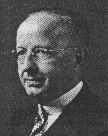Walter A. Shewhart
| Walter A. Shewhart |
|---|
| See also |
Walter A. Shewhart was born in 1891, New Canton, IL, died in 1967, Troy Hills, NJ. He was an American statistician, physicist, and engineer. Studied physics at the University of Illinois and University of California. Walter A. Shewhart was a father of statistical quality control. He changed direction of industrial history by linking together statistics, engineering and economics. His greatest achievement was inventing the control chart, which was a formulation of a scientific basis for securing economic control.
William Edwards Deming and Joseph M. Juran worked with Shewhart and learned from him basics of statistical quality approach. Therefore, Shewhart, however less known that Deming and Juran, can be viewed as a father of contemporary quality movement.
Industrial quality
In 1918 joined the Western Electric Company - manufacturer of telephone hardware for Bell Telephone. They had been working on improving the reliability of their transmission systems to reduce the frequency of failures and repairs. Shewhart's first assignment was to improve the voice clarity of the carbon transmitters in the handsets. Later he used his statistical methods in a final installation of central station switching system, then to factory production.
In 1924 Shewhart uncovered the problem in terms of assignable-cause and chance-cause variation and developed the control chart, a tool for distinguishing between that two. The use of tolerance limits was short-sighted because he realized that they provided a method for judging the quality of product that had already been made. Walter A. Shewhart distinguished between common causes, assignable causes and the natural variability of any process, lapse in the process which are economically reasonable to seek out and eliminate. Shewhart allowed managers to focus on future production, by using statistical probability. He worked in Bell Telephone Labolatories from 1925 to 1956.
Achievements
Shewhart published a series of papers in the Bell System Technical Journal. His book Economic Control of Quality of Manufactured Product was a summary of his earlier work. He also wrote Statistical method from the viewpoint of quality control in 1939 and A study of the accelerated motion of small drops through a viscous medium in 1917. The American Society for Testing Materials (ASTM) in 1933 adopt Shewhart's control chart.
- Control charts - it is the basic and oldest tool for statistical process control. Control charts are used to control variability and its causes. They are in the form of sheets that are so designed that operator can easily indicate changes of analysed parameter.
- Statistical process control - it is a set of techniques and statistical methods used to assess the stability of the process. The purpose of SPC is to prevent non-conformity by detecting and early signalling of interference in the process.
- Shewhart cycle - The PDCA cycle is also known as Shewhart cycle or Deming wheel. They all refer to the same tool of continuous improvement.
References
- Shewhart, W. A., & Deming, W. E. (1939). Statistical method from the viewpoint of quality control. Courier Corporation.
- Shewhart, W. A. (1931). Economic control of quality of manufactured product. ASQ Quality Press.
- Wikipedia article about W.A. Shewhart
